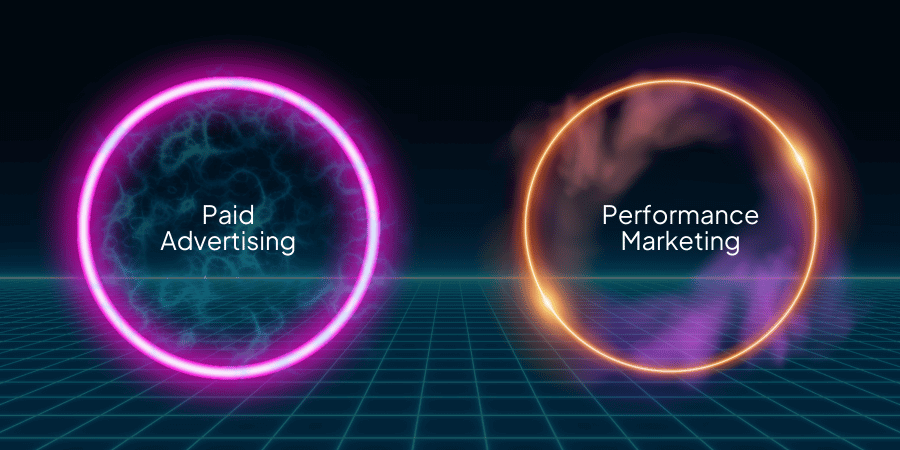Marketing tactics have become varied and complex over years. Among these, performance marketing & paid advertising frequently stand out as key components for companies looking for quantifiable outcomes. Though these terms are frequently used interchangeably, they represent distinct approaches within the marketing spectrum.
Table of Contents
In this blog, we aim to clarify the differences and similarities between performance marketing and paid advertising, providing valuable insights for anyone looking to understand the nuances.
Introduction
Marketing strategies are essential for driving growth and achieving business objectives. Performance marketing and paid advertising are two prominent approaches that businesses use to reach their target audience in an expedited manner. While they share common goals, such as increasing brand visibility and driving sales, their methods and metrics differ significantly.
What is Performance Marketing?
Performance marketing refers to a marketing strategy where advertisers pay only when specific actions are completed. These actions can include clicks, conversions, sales, or other measurable outcomes. The key characteristic of performance marketing is that advertisers only incur costs based on the achievement of predefined goals.
Key Features of Performance Marketing
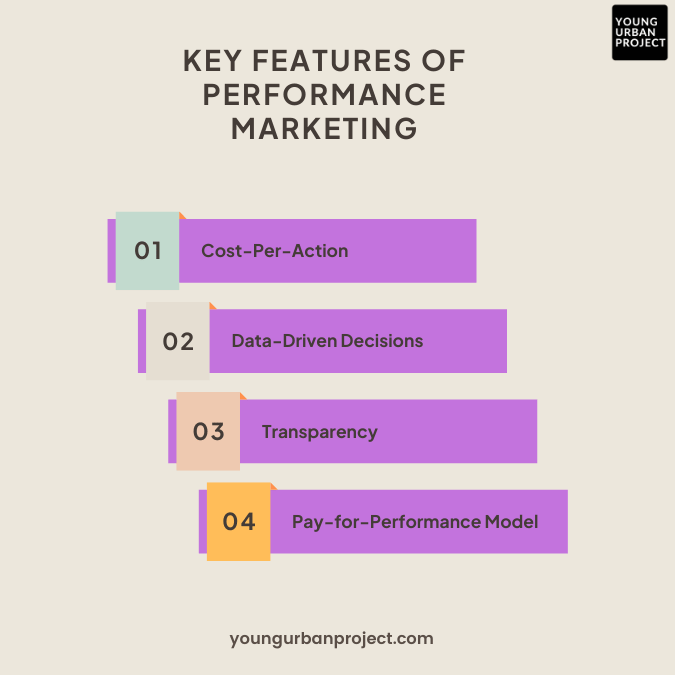
- Cost-Per-Action (CPA): Advertisers pay for specific actions, such as a click or a sale, rather than for ad placements or impressions. This ensures that marketing budgets are spent effectively and tied to actual performance.
- Data-Driven Decisions: Performance marketing relies heavily on data analytics. Campaigns are optimized based on performance metrics, enabling advertisers to make informed decisions and improve results over time.
- Transparency: Advertisers receive detailed reports on campaign performance, providing clear insights into how their budget is being utilized and the return on investment (ROI) achieved.
- Pay-for-Performance Model: Since costs are directly linked to outcomes, performance marketing aligns the interests of advertisers and publishers. This model incentivizes publishers to deliver high-quality traffic and conversions.
What does Performance Marketing Involve?
Performance marketing (also called as Growth Marketing) is a strategic approach where the marketers are focused on business growth (Acquisition and Retention).
It generally involves the following components:
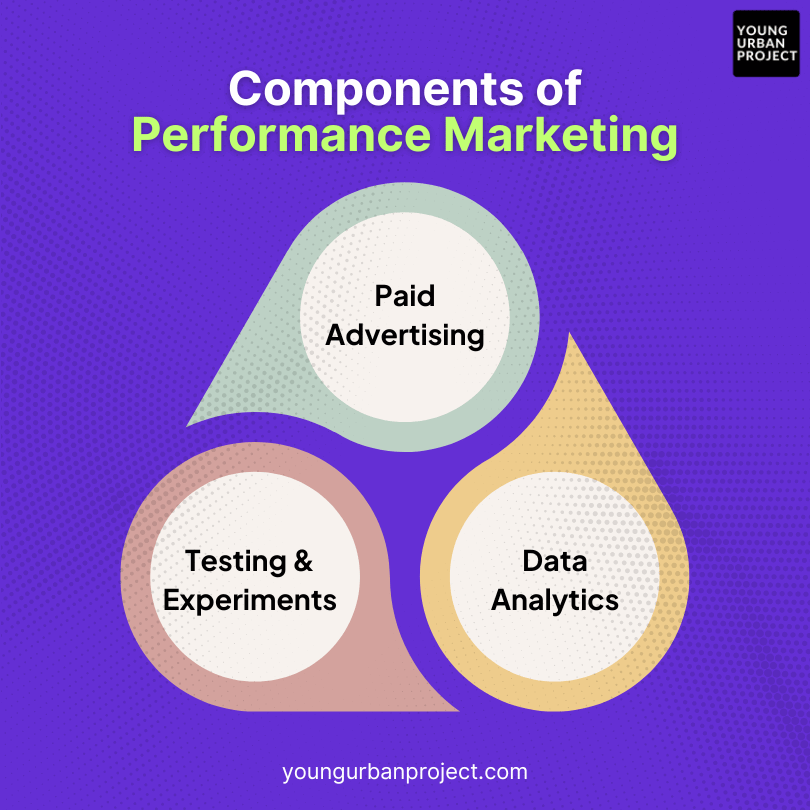
Paid Advertising: Basically, Running Ads. However, the focus in on ads that help achieve bottom of the funnel objectives (conversions). Platforms like Meta Ads, Google Ads, Linkedin Ads, X Ads, etc are used to generate these outcomes.
Optimize your ad campaigns with our Google Ads Cost Calculator
Data Analytics: Running ads doesn’t help unless the campaigns are tracked, measured, and optimised. This is where analytics become important. There are performance marketing tools that help performance marketers accomplish this – like Google Analytics, Adobe Analytics, Mixpanel, Amplitude and more.
Testing & Experimentation: The data gathered from analytics tools needs to be deciphered in order to turn them into observations, insights, and learnings. These observations are then turned into hypotheses. The hypotheses are then tested using statistical experimentation techniques like Spilt tests, Multivariate tests etc. The findings from these experiments are then converted into actions that help improve conversion rates (also called CRO or Conversion Rate Optimization)
What is Paid Advertising?
Paid advertising, often referred to as “paid media,” encompasses various forms of advertising where businesses pay to display their ads across different channels. Unlike performance marketing, paid advertising may not always involve a direct link between cost and specific actions.
Key Features of Paid Advertising
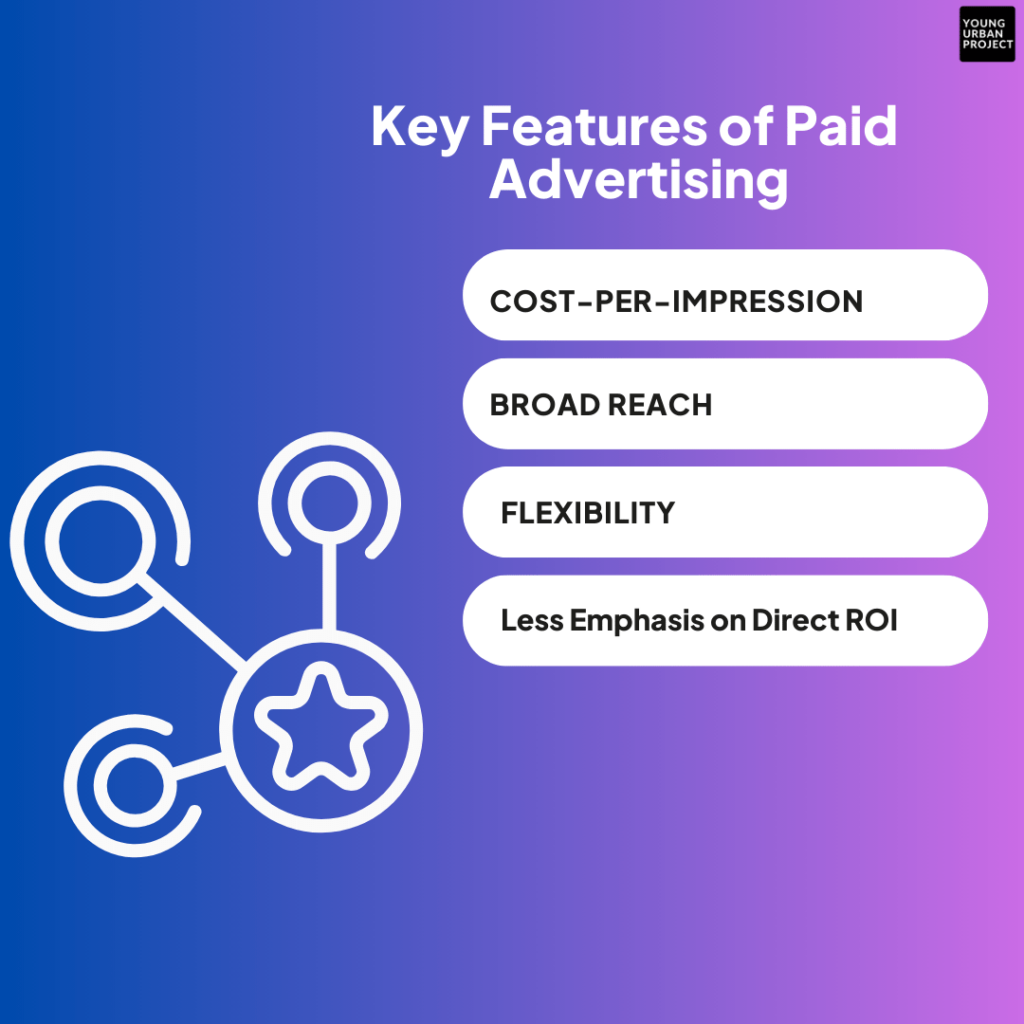
- Cost-Per-Impression (CPM): In many paid advertising models, advertisers pay based on the number of times their ad is displayed, regardless of whether users take any action. This model is often used in display advertising and brand awareness campaigns.
- Broad Reach: Paid advertising offers the ability to reach a wide audience through various platforms, such as search engines, social media, and display networks. This approach focuses on increasing visibility and brand awareness.
- Flexibility: Advertisers have the flexibility to choose different ad formats, placements, and targeting options. This allows for creative and strategic ad placements tailored to specific audience segments.
- Less Emphasis on Direct ROI: While paid advertising aims to drive traffic and brand awareness, it may not always provide immediate or direct ROI. The effectiveness of paid advertising campaigns can be influenced by various factors, including market conditions and audience behavior.
Examples of Paid Advertising
- Display Ads: Banner ads displayed on websites or apps. Advertisers pay for ad impressions, and these ads aim to increase brand visibility and attract potential customers.
- Social Media Ads: Ads are placed on platforms like Facebook, Instagram, and Twitter. Advertisers can choose from different formats, such as image ads, video ads, and carousel ads, and pay for impressions or clicks.
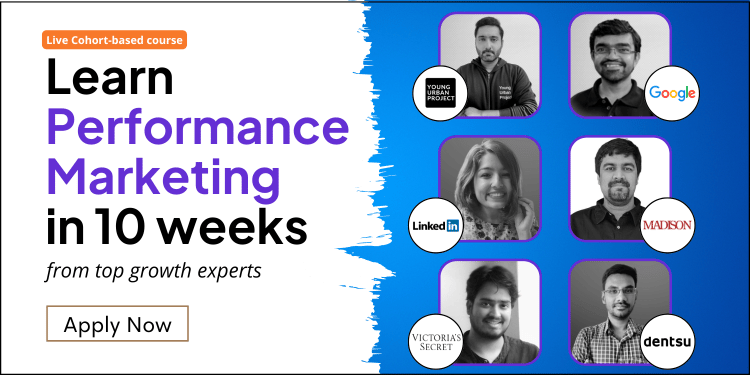
Enroll Now: Online Performance Marketing Training
Performance Marketing & Paid Advertising: Key Differences
1. Cost Structure
- Performance Marketing: Costs are based on specific actions, such as clicks, conversions, or sales. Advertisers pay only when these actions occur, ensuring a direct correlation between spend and results.
- Paid Advertising: Costs may be based on impressions (CPM) or clicks (CPC), regardless of whether users take any further action. This can result in a focus on broad reach rather than direct performance metrics.
2. Measurement and Optimization
- Performance Marketing: Measurement is centered around specific actions and performance metrics. Campaigns are continuously optimized based on data to improve results and achieve better ROI.
- Paid Advertising: Measurement often focuses on reach and visibility metrics, such as impressions and clicks. Optimization may involve adjusting targeting options and creative elements to enhance ad performance.
3. Alignment of Interests
- Performance Marketing: The pay-for-performance model aligns the interests of advertisers and publishers. Publishers are incentivized to deliver high-quality traffic and conversions to maximize their earnings.
- Paid Advertising: Advertisers pay for ad placements or impressions, which may not always directly align with performance outcomes. Publishers earn revenue based on ad display or clicks, regardless of resulting actions.
Key Similarities Between Performance Marketing and Paid Advertising
1. Goal-Oriented
Both performance marketing and paid advertising aim to achieve specific marketing goals, such as increasing brand visibility, driving traffic, or generating sales. The ultimate objective is to reach and engage target audiences effectively.
2. Digital Channels
Both approaches utilize digital channels to deliver ads and reach audiences. These channels include search engines, social media platforms, websites, and mobile apps, allowing for diverse and targeted advertising strategies.
Read more: Types Of Performance Marketing Channels
3. Data Utilization
Data plays a crucial role in both performance marketing and paid advertising. Advertisers analyze performance data to make informed decisions, optimize campaigns, and achieve better results. Analytics tools provide insights into audience behavior, ad performance, and ROI.
Conclusion
Performance marketing vs paid advertising are integral components of modern marketing strategies, each offering unique advantages and approaches. Performance marketing focuses on measurable actions and cost-effectiveness, aligning the interests of advertisers and publishers. On the other hand, paid advertising emphasizes broad reach and brand visibility, with costs often tied to ad placements or impressions.
Understanding the differences and similarities between these approaches allows businesses to choose the strategy that best aligns with their goals and objectives. By leveraging both performance marketing and paid advertising effectively, businesses can enhance their marketing efforts, drive growth, and achieve a positive return on investment. For those looking to master the intricacies of performance marketing and harness its full potential, Young Urban Project provides the best performance marketing Program. With a curriculum designed to cover essential topics, hands-on experience, and mentorship from industry experts, this course equips you with the skills and knowledge needed to excel in the dynamic world of performance marketing.

